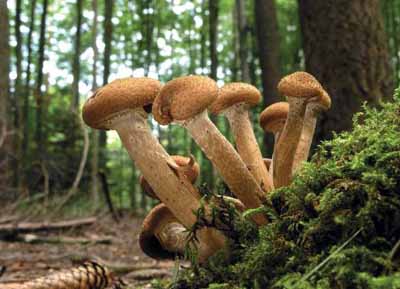The world's largest living organism
 Armillaria ostoyae (Latin = armillary bracelet, Armillaria = relevant to bracelets, ring on her) is a very common fungus belonging to the family Marasmiaceae.
Armillaria ostoyae (Latin = armillary bracelet, Armillaria = relevant to bracelets, ring on her) is a very common fungus belonging to the family Marasmiaceae.
The peculiarity of this species is the fact that one of his pieces is the largest living thing in the world. It is also one of the most common fungi.
Its mycelia attack the roots of the nearby trees and are able to cover large distances under the ground, among the trees.
As most of the parasitic fungi, also Armillaria ostoyae reproduces sexually. The mushrooms begin their new life in the form of white spores released into the air by the mature specimens. At this point, the spores can be dispersed in the environment by natural factors (for examples the wind) or can be ridepositate by an animal.
Once the spores are in a state of rest , each of them can come into contact with another of the opposite sex of the same species. If the spores do not belong to the same species, they remain separate. When, however, we encounter two spores of the same species and opposite sex damage a colony that its color becomes dark brown and flat shape. The fruiting body continues to grow and get nutrients: form a new specimen of mature mushroom which in turn will release the spores completing , thus, the life cycle.
The peculiarity of this species is that one of his specimens, currently living in the Malheur National Forest of Oregon, is the world's largest living thing. It covers approximately 890 hectares (equivalent to 8,900,000 square meters or 1,665 football fields! Moreover, its age is estimated between 2,000 and 8,000 years old, most likely 2,400 years. This specimen is located, for the most part, below ground, in the form of a gigantic web of mycelia (a kind of roots) white in color and covered with tentacles. These extend into the ground and surrounding trees die for lack of vital substances. Mycelia in some areas emerge from the ground and appear as of isolated specimens. This characteristic has led, for many years, to underestimate this copy which was not considered as a single organism. Only recently some researchers have confirmed that it is a single living being (the largest available) totally connected in soil.
Experts believe that this "gigantism" , may be due to the particularly dry climate of Oregon climate that does not facilitate the spread of the mycelium by spore. This has to adapt the species, which can not reproduce with ease because of the climate, to a phenomenon of gigantism also for the lack of interspecies competition.
The second largest mushroom in the world, with approximately 1,000 years old, was discovered in Switzerland in the canton of Grisons, also in this case it is an Armillaria ostoyae.




